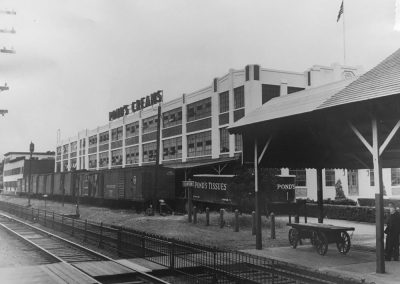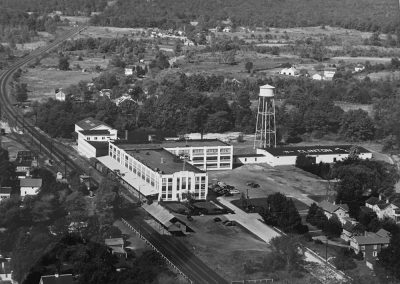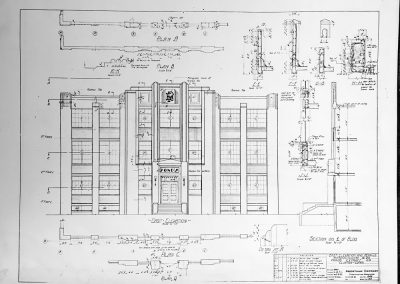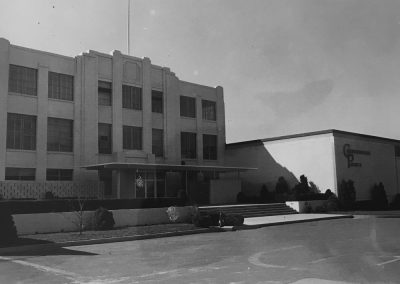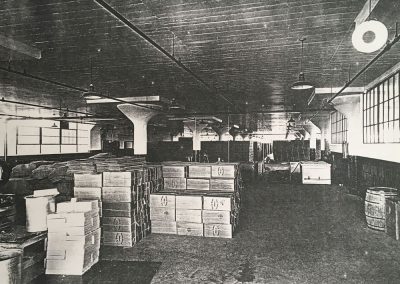The History.
The story of the Pond’s Extract Company began in 1846 in Utica, New York, where pharmacist Theron T. Pond (1800-1852) developed a witch hazel extract with an Oneida Indian medicine man. They sold their product under the name “Golden Treasure,” as a salve for burns and other skin ailments. Three years later, Pond established the T. T. Pond Company, with Alexander Hart and Edmund Munson. Hart and Munson kept the company going after Pond’s death in 1852, marketing the product as “Pond’s Extract.”[1]

The Pond’s Building
After changes in ownership, the business was renamed the Pond’s Extract Company and moved in the 1870s to Chester, Connecticut, an area where wild witch hazel was abundant. The company relocated its plant to Clinton in 1888, occupying the former Clinton Manufacturing Company’s factory. Located on John Street next to the Shore Line Railroad, the Clinton Manufacturing Company made products such as Whittemore’s Oriental shaving soap.[2]
The Pond’s Extract Company built a large new factory on the John Street site and expanded it between 1895 and 1901. The factory was a seasonal operation, processing witch hazel from November through January, and making soap products like its predecessor.[3]
In 1904, the company introduced two new skincare products: Pond’s Cold Cream and Pond’s Vanishing Cream, and in 1908 the factory expanded to accommodate bottling and shipping operations. The two creams were very successful products and the company and its factory continued to grow and develop new products. Pond’s Skin Freshener and Cleansing Tissues were introduced in 1927.[4]
By the late 1920s Pond’s was outgrowing its plant. It hired the Aberthaw Company, a construction firm based in Lowell, Massachusetts, to erect a new factory on former house lots on the east side of the existing plant.[5] The three-story Art Deco building was completed in 1929. It is 230’-0” by 80’-8”, three stories high, with a total of 77,000 square feet.
The concrete building was enlivened with multi-colored brick panels under the windows and blue faience tile at the tops of pilasters. Above the main entrance was a faience tile monogram, with interlocking letters “PECo” for Pond’s Extract Company. “POND’S” was also spelled out in tile letters above the front door.
Inside, the building represented modern trends in factory design, with large operable windows for natural light and ventilation, smooth concrete floors for easy cleaning, and widely spaced columns for spatial flexibility.
As the company expanded its product line in the 1930s with modestly priced cosmetics like powder and lipstick—popular during the Great Depression—it needed additional space. It opened a plant in London and in 1936, the Clinton factory was expanded with a three-story rear wing, between a 19th-century building and the 1929 plant. The new building was 213’-4” by 80’-0,” adding 53,000 square feet. Its cost was about $135,000 (about $2.5 million in 2019 dollars). The Pond’s product line developed into a wide range of skin care products and cosmetics, manufactured and sold around the world.[6]
In 1955, the Pond’s Extract Company merged with the Chesebrough Manufacturing Company, forming Chesebrough-Ponds. The company completed a large new addition on the north side of the 1929 building in 1958. At that time, the older building’s entrance was renovated in the same Modern style, with new landscaping and a flat-roofed glass vestibule. The building’s decorative flourishes, such as the brick panels and the “PECo” monogram, were painted over in an effort to update the building’s appearance.
In the 1980s, Chesebrough-Ponds’ revenue began to decline and acquisition of the Stauffer Chemical Company added significant debt. The Dutch company Unilever bought Chesebrough Ponds in 1986 for $3.1 billion.[7] In 2012, Unilever closed the Clinton plant, ending the 124-year factory presence at the site.
[1] Edmund H. Fulling, “American Witch Hazel: History, Nomenclature and Modern Utilization.” Economic Botany 7: 4 (October-December 1953): 359-381.
[2] https://www.historicnewengland.org/explore/collections-access/capobject/?refd=EP001.01.028.03.04.013; Bryant, Tod, “High Street Historic District [Clinton, Connecticut].” National Register of Historic Places Inventory/Nomination Form, Draft December 15, 2017.
[3] Sanborn Fire Insurance map of Clinton, Connecticut. Sanborn Map Company, 1901.
[4] https://cosmeticsandskin.com/companies/chesebrough-ponds.php.
[5] The Aberthaw Company was founded in 1894 and remains in business today, https://www.aberthawcc.com/.
[6] https://cosmeticsandskin.com/companies/chesebrough-ponds.php.
[7] https://cosmeticsandskin.com/companies/chesebrough-ponds.php.
For more information, please just fill out the form below or email us.

Contact:
The Station at Clinton
1 John Street, Clinton CT 06413
Phone: 860-552-4555
info@thestationatclinton.com

